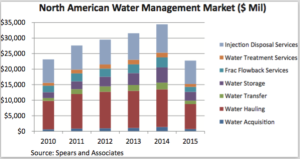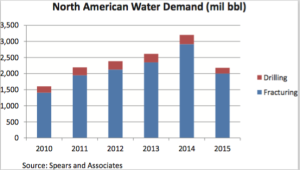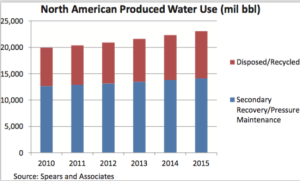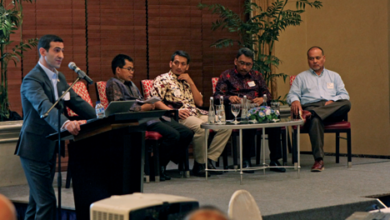Industry looks to mobile solutions, alternative transportation methods to reduce water management costs
Treating and reusing produced water remains a high-cost option, but optimized water hauling routes, lay-flat pipes are helping to cut costs in Permian, Eagle Ford
By Kelli Ainsworth, Editorial Coordinator

The general public harbors numerous skewed perceptions about hydraulic fracturing – among them that the fracturing process requires astronomical amounts of fresh water. However, data from a 2015 Duke University study, “Water Footprint of Hydraulic Fracturing,” indicates that fracturing accounts for less than 1% of total industrial water use in the United States. Other methods of energy extraction, such as coal and uranium mining, actually use 2.5 to 13 times more water than hydraulic fracturing, according to the report.
That is not to say that the oil and gas industry is not prioritizing water management. In 2015, the oil and gas industry spent more than $22 billion on sourcing, hauling, storing, treating and disposing of water, according to data from Spears and Associates. The bulk of that money went toward water hauling and disposal. “Those are the two biggest parts of the market. Each one represents about 30% of the total,” John Spears, the firm’s President, said.
In plays like the Eagle Ford and the Permian, which are located in naturally drier regions in Texas, sourcing fresh water is typically a costly challenge, particularly in drought years. Farther north in the Marcellus, disposal presents bigger problems because regulations limit the number of disposal wells within the region. This means that operators often have to haul the water a longer distance for disposal, increasing transportation costs.
Last year, it’s estimated that North American wells generated 23 billion barrels of produced water. Of these 23 billion, 14 billion were reused in secondary recovery/pressure maintenance operations. That left 9 billion barrels of produced water to be taken to injection sites, which means there is opportunity for additional recycling. In 2015, 2.2 billion barrels of water were required for drilling and hydraulic fracturing, of which about 10% represented recycled fluids, twice the percentage that recycled fluids represented in 2012, Mr Spears pointed out. “If we have roughly 9 billion barrels of produced water to be disposed of, and we need 2 billion barrels for fracturing and drilling, there’s an opportunity to take some of that water, clean it up and use it in the fracking process.”
Currently, it’s still uncommon and quite costly for produced water to be treated to a level where it could be used for fracturing or even agricultural irrigation. However, technology advances could help to bring costs down. Further, “whenever your transportation costs rise high enough, that provides an opportunity for recycling to maybe become an economic alternative,” Mr Spears said.

The industry use of water for fracturing is on the rise – not just because more wells are being drilled that need to be fracked, but also because operators are putting more and frac stages into each wellbore. This means more proppant and more water used, Mr Spears said. He estimates that the amount of proppant used per frac job increased by an average 25% between 2014 and 2015. The amount of water used per frac job has trended similarly, he added.
Because the industry has to handle billions of barrels of produced water per year, lowering the cost of managing that water by even $1 per barrel could result in tremendous cost savings, said Josh Adler, CEO of SourceWater, an online marketplace for water transport and treatment in the Marcellus and the Permian basins, launched in early 2015. All major operators in the Marcellus have utilized the service, and most of the top ten operators in the Permian are involved in the pilot program there, Mr Adler said. “A $1/bbl savings on their water management costs is equivalent to a 2.5% reduction in operators’ operating costs,” he said.
Besides being a place for water service providers to market their services, SourceWater also provides an avenue for water exchange. If one operator has a large quantity of produced water that it cannot use itself, the website could help the company to locate a nearby operator that is looking for water and willing to accept produced water. Hauling the water to another well site a few miles away might be cheaper than transporting it to a disposal facility farther away. The operator receiving the water gets paid to take the water and treat it for reuse in their well, rather than paying for freshwater. “One operator is able to pay another operator to be their disposal, and the other operator is getting paid to receive water that normally they’d have to buy,” Mr Adler said. “Both sides win.”
Reducing transportation costs
For operators in the Permian, providing fresh water to well sites and then transporting produced water to treatment or disposal facilities both strain economically challenged projects, said Clay Garcia, Associate Mechanical Engineer for BHP Billiton’s Permian Operations Unit. On the sourcing side, many of the Permian’s well pads are located in remote locations without nearby access to fresh water. At the same time, Permian wells tend to produce high volumes of water, which operators either have to treat for reuse or haul off for disposal. “It seems common sense that you could just treat the produced water and use it as your source, but the challenge for that is cost,” Mr Garcia said.

On average, 30% of water the company uses for well completions in the Permian is recycled water, said Ed Mongan, Senior Manager for Regulatory and Environment. Last year, BHP Billiton replaced 2.2 million barrels of fresh water with recycled water that would have otherwise required disposal.
The ideal for water recycling, Mr Mongan said, would be to treat 100% of produced water. “To me that would be the gold standard, if you could treat your produced water so that it could not only be used in fracturing but for agricultural purposes.” However, treating water to that level is not a cheap proposition, and in a time when the industry is struggling to make its operations as economic as possible, this isn’t a realistic option for most companies.
Currently, BHP Billiton is focusing on lowering its costs for transporting water by working with haulers to optimize routes. The company is also increasing its use of pipelines to transport water, rather than using trucks. While installing the pipelines and the pumps necessary to move water from one site to another has its own associated costs, Mr Garcia said, the savings quickly make up for it. “For the most part, the pipelines and the pumps we install have paid themselves off in a matter of months,” he said. “On the production side, handling produced water is our biggest lifting cost. Being able to get water in a pipeline has a big impact on trying to be profitable when producing in West Texas.”
In both the Permian and Eagle Ford, BHP Billiton has utilized lay-flat pipes to transport freshwater between sites that are less than 7 miles apart. These pipes are similar to hoses, can be rolled off a truck and quickly put in place. “It’s very transportable and very easy to set up,” Mr Mongan said. “It’s also better for the community to have fewer trucks with water moving around on the road. We put a lot of effort into looking for ways to set up pipelines rather than having to deal with trucks.” BHP Billiton said it has been able to significantly reduce water transportation and disposal costs in the Permian due to these efforts.

Cooperation among operators on how to deal with water management is growing, Mr Mongan said. BHP Billiton is a member of the South Texas Energy and Economic Roundtable (STEER), an operator-led organization founded in 2012. It advocates for the oil and gas industry in the Eagle Ford and works to foster a positive relationship between the industry and local communities. The organization has a water sustainability committee, focused on knowledge sharing on water management.
One of the committee’s initiatives is to seek out nearby water supplies, such as brackish water, that are not suitable for agricultural applications or as drinking water but that could be used in drilling and fracturing. “That way, the industry can utilize water that’s not necessarily competing with other users,” Mr Mongan said.
In the Permian, BHP Billiton said it is moving to explore opportunities to cooperate with other operators in the region including participating in the Permian Basin Oil and Gas Association Water Management Committee. The company has set up meetings with other operators in the area and sent their foremen and superintendents to other operators’ facilities and vice versa to share best practices around water management. “I think the current oil price has increased this opportunity because everybody out there is facing tough times and doing their best to cut costs,” Mr Garcia said.
Alternative business models
Water treatment companies are acutely aware of the difficult economics operators are facing, said Kirk Wagner, President of Monarch Separators, which merged with Water Standard in January. However, in order to help operators lower their water management costs, Mr Wagner said there must be greater levels of direct cooperation between operators and water treatment companies. “When they have a challenge, we very much want to be a part of that conversation. We can add tremendous value to their decisions, whether it’s via partnerships or just being more engaged.”
Early engagement might also open up the possibility of different business models, such as leasing or rent-to-own. Compact technologies that can be moved from site to site lend themselves to such business models, Mr Wagner said. For example, where central treatment facilities are not a viable option, perhaps due to budget constraints or installation challenges, compact technologies can be considered, particularly if they can be moved between multiple well pads, not just within a single well pad. Where central treatment facilities are the preferred solution, compact technologies provide rapid design/build solutions, with smaller footprints, allowing for smaller facilities and allowing these facilities to treat water and create revenue more rapidly.

“We’re seeing customers want to treat water from various wells at different locations with limited budgets and within an environment of increased public scrutiny over the trucking of water,” Mr Wagner said. “We’re currently offering compact technologies that allow the operator to not only meet their budget constraints but also to treat water at the well site or within smaller a central processing facility where pipelines are used to move the produced water instead of trucking that water to different sites.”
With an estimated average of three barrels of water being produced with every barrel of oil, Monarch Separators is working on developing solutions such as compact versions of its various produced water treatment technologies. These include hydrocyclones, gas flotation and filtration technologies. The hydrocyclones use small vessels with special internals designed to create a centrifugal force to spin immiscible liquids (hydrocarbons and produced water) and separate the lighter phase (hydrocarbon) from the heavier phase (produced water).
In the compact gas flotation systems, microbubbles are injected into the produced water and attached to solids and hydrocarbons in the water. These bubbles then float to the surface and are removed from the water. Compact filtration allows operators to meet very strict discharge or injection standards – less than 2 micron of particles – within a smaller footprint. The company estimates that compact versions of these technologies could be up to 10 times smaller than the conventional versions.
Reuse and discharge
Produced waters vary widely in quality across geological formations. The salt content of the produced water is characterized by total dissolved solids (TDS), which ranges between 500 mg/l to 300,000 mg/l across in US geological formations.
In the Western US, produced water is generated primarily from the steam flood oil productions fields, which often contains less than 15,000 mg/l of TDS, while water produced from shale oil and gas operations in the Southern and Eastern US could contain between 30,000 to 300,000 mg/l of TDS, said Lnsp Nagghappan, Senior Director of Business Development for Veolia Water Technologies. Therefore, the same water treatment technologies cannot be applied universally.
“There’s no one silver bullet technology which will enable you to treat all the produced waters generated from the various geological formations,” he said. “You will need multiple innovative technologies, consisting of pretreatment, membrane and thermal processes, to achieve a quality that’s suitable for reuse or surface discharge.”

In 2005, Veolia launched its OPUS Technology, Optimized Pretreatment and Unique Separation reverse osmosis (RO), for treatment of produced water from oilfields for surface discharge. This technology has been used at the Chevron San Ardo oil production facility in California to minimize the volume of produced water requiring deep well injection and to create fresh water suitable for irrigation. “OPUS is a reverse osmosis-based membrane technology that allows you to achieve higher recovery rates with a unique pretreatment approach on highly challenging produced waters,” Mr Nagghappan said.
If the operator is looking to reuse the produced water for fracturing operations, the main requirement has been removal of particulates – oil, solids, bacteria – and scale formers – iron, barium, calcium. Further treatment to remove additional contaminants, such as TDS, boron, ammonia, arsenic and dissolved organics, would be required if the water is to be used in irrigation.
Veolia recently launched OPUS II, an updated version of the treatment process with ceramic membrane pretreatment. In the OPUS II process, the produced water goes through a pretreatment process before passing through a crystallization tank, which softens the water. The water and crystalline solids then pass through a ceramic membrane, CeraMem, to reduce concentrations of free oil, total hardness and suspended solids. The solid waste generated is dewatered and landfill disposed. The ceramic membrane-filtered water is then further softened through an ion exchange process to remove residual hardness and metals.
Now pretreated, the water is subjected to RO at an elevated pH to reduce the TDS, boron and organics. The high pH operation of the RO process, along with ceramic membrane pretreatment, which prevents fouling and scaling of the RO membranes, is unique to OPUS II, Mr Nagghappan said. The technology is able to remove more than 99% of free oil, suspended solids, hardness, calcium, magnesium, boron, organics and silica. The technology has been operated for the past three years at an oil production facility in central California.

The technology is best-suited for produced water with relatively low TDS (less than 15,000 mg/l), such as that found in California and Colorado. Produced water with higher levels of TDS will require a thermal technology, such as Veolia’s CoLD Crystallization processes. The company is currently constructing a centralized water treatment facility in the Marcellus to deploy the technology; it’s expected to come online within two years.
The CoLD process crystallizes high solubility salts at a low temperature in a deep vacuum. “It’s a low-cost crystallization process compared to other thermal technologies,” Mr Nagghappan said. Typically, thermal processes for salt removal from produced water require calcium removal using lime and soda ash. With Veolia’s process, calcium removal will not be required.
When the temperature of the produced water is lowered, dissolved solids will crystallize at relatively low concentrations. This eliminates the need for calcium removal in the pretreatment. The final solid waste product does not need to undergo additional drying before being disposed.
Veolia is currently researching ways to make its technology offerings more economical for operators. According to the company, one way the industry can work together to reduce the costs for water treatment is if operators agree to share a treatment plant, a centralized merchant treatment facility in a geographic area, rather than each operator requesting its own. “That solution will drive the cost of water treatment substantially lower,” he said. He estimates that such an approach could reduce treatment costs by approximately 30-40%.
While operators historically have preferred to use individual facilities, the culture is starting to change. “The low oil price environment is forcing operators to look at other mechanisms that can lower operating costs than what they’ve historically utilized.”
At the same time, the company is also exploring mobile solutions as a result of the shale oil and gas market demand for reuse of produced water at the well site. For instance, the company has developed a compact mobile technology for reuse applications at the wellhead. “We’re adapting to demand and building mobile solutions for removing contaminants so that the technology can be applied at each drilling pad for reuse,” Mr Nagghappan said. DC
- In 2015, the oil and gas industry spent more than $22 billion on sourcing, hauling, storing, treating and disposing of water.
- 30% of the money spent on water management was spent on water hauling and disposal.
- Last year, it’s estimated that North American wells generated 23 billion barrels of produced water. Of these 23 billion, 14 billion were reused in secondary recovery/pressure maintenance operations.
- In 2015, 2.2 billion barrels of water were required for drilling and hydraulic fracturing, approximately 10% of which represented recycled fluids.
- The amount of proppant used per frac job increased by an average 25% between 2014 and 2015. The amount of water used per frac job has trended similarly.
- On average, 30% of water BHP Billiton uses for well completions in the Permian is recycled water.
- The range of TDS’s in US geological formations can range between 500 to 300,000 mg/l.
OPUS, CeraMem and CoLD Crystallization are registered terms of Veolia Water Technologies.




